Comprehensive Solutions to Prevent Larvae Breakout in Water Filtration Systems
Abstract
:1. Introduction
2. Materials and Methods
2.1. Larvae Sampling Site
2.2. Filter Media Preparation
2.3. Pilot-Scale System
2.4. Experiment Protocols
2.5. Quality Control
3. Results and Discussion
3.1. Larvae Breakouts from Various Types of Filtration Columns
3.2. Larvae Breakouts in Relation to Sand Depth in Filtration Columns
3.3. Larvae Breakouts in Different Pretreatment Methods Prior to Sand Filtration
3.4. Impact of Effective Size and Uniformity Coefficient on Larvae Removal
3.5. Application of Optimum ES and UC of Sand Media in Sand/GAC and Sand/Anthracite Filters
3.6. Impact of Water Quality on Larvae Breakout
3.7. Evaluation of Larvae Removal Using Backwashing
4. Conclusions
Supplementary Materials
Author Contributions
Funding
Institutional Review Board Statement
Informed Consent Statement
Data Availability Statement
Acknowledgments
Conflicts of Interest
References
- Pan, J.; Yu, L.; Shan, Q.; Yu, J.; Guo, Y. Inactivation of Chironomid Larva in Water with Bacillus thuringiensis Subsp. Israelensis. Int. J. Water Wastewater Treat. 2015, 1, 1–4. [Google Scholar] [CrossRef]
- Reyes-Maldonado, R.; Marie, B.; Ramírez, A. Rearing Methods and Life Cycle Characteristics of Chironomus Sp. Florida (Chironomidae: Diptera): A Rapid-Developing Species for Laboratory Studies. PLoS ONE 2021, 16, e0247382. [Google Scholar] [CrossRef] [PubMed]
- Bichai, F.; Payment, P.; Barbeau, B. Protection of Waterborne Pathogens by Higher Organisms in Drinking Water: A Review. Can. J. Microbiol. 2008, 54, 509–524. [Google Scholar] [CrossRef] [PubMed]
- van Lieverloo, J.H.M.; van der Kooij, D.; Hoogenboezem, W. Invertebrates and Protozoa (Free-Living) in Drinking Water Distribution Systems. In Encyclopedia of Environmental Microbiology; John Wiley & Sons, Inc.: Hoboken, NJ, USA, 2003. [Google Scholar]
- Gunkel, G. Evaluation of Invertebrates in Drinking Water Networks. Water 2023, 15, 1391. [Google Scholar] [CrossRef]
- Wagenvoort, A.; van Asperen, R.; Sandrini, G.; Hijnen, W. Changes in Water Source Cause Shifts in Invertebrate Biomass, Composition, and Regrowth in a Non-Chlorinated Drinking Water Distribution System. Water 2023, 15, 732. [Google Scholar] [CrossRef]
- Zhou, L.; Zhang, J.; Lei, P. The Research Trends of Preventions of Chironomid Larvae Pollution in Drinking Water Treatment. Water Wastewate 2003, 29, 25–28. [Google Scholar]
- Hidayaturrahman, H.; Kwon, H.J.; Bao, Y.; Peera, S.G.; Lee, T.G. Assessing the Efficacy of Coagulation (Al3+) and Chlorination in Water Treatment Plant Processes: Inactivating Chironomid Larvae for Improved Tap Water Quality. Appl. Sci. 2023, 13, 5715. [Google Scholar] [CrossRef]
- Christopher, S.; Michels, U.; Gunkel, G. Paratanytarsus Grimmii (Chironomidae) Larvae in Drinking Water Distribution Systems: Impairment or Disaster? Water 2023, 15, 377. [Google Scholar] [CrossRef]
- Kang, H.J.; Baek, M.J.; Kang, J.H.; Bae, Y.J. DNA Barcoding of Chironomid Larvae (Diptera: Chironomidae) from Large Rivers in South Korea to Facilitate Freshwater Biomonitoring and Public Health Surveillance. Int. J. Environ. Res. Public Health 2022, 19, 12035. [Google Scholar] [CrossRef]
- Frouz, J.; Matěna, J.; Ali, A. Survival Strategies of Chironomids (Diptera: Chironomidae) Living in Temporary Habitats: A Review. Eur. J. Entomol. 2003, 100, 459–465. [Google Scholar] [CrossRef]
- Jiang, J.-Q. The Role of Coagulation in Water Treatment. Curr. Opin. Chem. Eng. 2015, 8, 36–44. [Google Scholar] [CrossRef]
- Cui, H.; Huang, X.; Yu, Z.; Chen, P.; Cao, X. Application Progress of Enhanced Coagulation in Water Treatment. RSC Adv. 2020, 10, 20231–20244. [Google Scholar] [CrossRef]
- Li, X.R.; Huang, M.S.; Leng, P.E.; Lu, X.Y.; Xiao, B. Coagulation-Flocculation: A Potential Application for Mosquito Larval Source Management (LSM). Acta Trop. 2021, 213, 105748. [Google Scholar] [CrossRef]
- Song, S.; Rong, L.; Dong, K.; Liu, X.; Le Clech, P.; Shen, Y. Particle-Scale Modelling of Fluid Velocity Distribution near the Particles Surface in Sand Filtration. Water Res. 2020, 177, 115758. [Google Scholar] [CrossRef] [PubMed]
- Bhutiani, R.; Ahamad, F.; Ruhela, M. Effect of Composition and Depth of Filter-Bed on the Efficiency of Sand-Intermittent-Filter Treating the Industrial Wastewater at Haridwar, India. J. Appl. Nat. Sci. 2021, 13, 88–94. [Google Scholar] [CrossRef]
- Dirkx, W.-J.; Beek, R.; Bierkens, M. The Influence of Grain Size Distribution on the Hydraulic Gradient for Initiating Backward Erosion. Water 2020, 12, 2644. [Google Scholar] [CrossRef]
- Braun, L.; Sylivester, Y.D.; Zerefa, M.D.; Maru, M.; Allan, F.; Zewge, F.; Emery, A.M.; Kinung’hi, S.; Templeton, M.R. Parameters for Effective Sand Filtration of Schistosoma Mansoni Cercariae from Water. Water Supply 2022, 22, 1943–1950. [Google Scholar] [CrossRef]
- Yu, Y.; Huang, X.; Chen, R.; Pan, L.; Shi, B. Control of Disinfection Byproducts in Drinking Water Treatment Plants: Insight into Activated Carbon Filter. Chemosphere 2021, 280, 130958. [Google Scholar] [CrossRef]
- Backer, H.; Hill, V. Water Disinfection. In CDC Yellow Book; Centers for Disease Control and Prevention: Atlanta, GA, USA, 2018; pp. 72–80. [Google Scholar]
- Kong, J.; Lu, Y.; Ren, Y.; Chen, Z.; Chen, M. The Virus Removal in UV Irradiation, Ozonation and Chlorination. Water Cycle 2021, 2, 23–31. [Google Scholar] [CrossRef]
- Sun, X.-B.; Cui, F.-Y.; Zhang, J.-S.; Xu, F.; Liu, L.-J. Inactivation of Chironomid Larvae with Chlorine Dioxide. J. Hazard. Mater. 2007, 142, 348–353. [Google Scholar] [CrossRef]
- Bartlett, J.C.; Convey, P.; Hayward, S.A.L. Life Cycle and Phenology of an Antarctic Invader: The Flightless Chironomid Midge, Eretmoptera Murphyi. Polar Biol. 2019, 42, 115–130. [Google Scholar] [CrossRef] [PubMed]
- Panis, L.I.; Goddeeris, B.; Verheyen, R. On the Relationship between Vertical Microdistribution and Adaptations to Oxygen Stress in Littoral Chironomidae (Diptera). Hydrobiologia 1996, 318, 61–67. [Google Scholar] [CrossRef]
- Xu, L.; Campos, L.C.; Li, J.; Karu, K.; Ciric, L. Removal of Antibiotics in Sand, GAC, GAC Sandwich and Anthracite/Sand Biofiltration Systems. Chemosphere 2021, 275, 130004. [Google Scholar] [CrossRef] [PubMed]
- Lee, C.Y.; Byeon, J.; Kim, M.K.; Lee, T.; Kim, D.G. Passability of Chironomid Larvae in Granular Activated Carbon. Int. J. Environ. Res. Public Health 2022, 19, 1005. [Google Scholar] [CrossRef]
- Baek, Y.; Lee, K.; Yang, Y. A Study on the Behavior Evaluation and Control of Midge Larvae in the Filtration Process. J. Korean Soc. Environ. Eng. 2022, 44, 418–425. [Google Scholar] [CrossRef]
- Adam, K.; Heath, R.G.M.; Steynberg, M.C. Invertebrates as Biomonitors of Sand-Filter Efficiency. Water SA 1998, 24, 43–48. [Google Scholar]
- Karima, Z. Chironomidae: Biology, Ecology and Systematics. In The Wonders of Diptera: Characteristics, Diversity, and Significance for the World’s Ecosystems; IntechOpen: London, UK, 2021; pp. 1–25. [Google Scholar]
- Hijnen, W.A.M.; Suylen, G.M.H.; Bahlman, J.A.; Brouwer-Hanzens, A.; Medema, G.J. GAC Adsorption Filters as Barriers for Viruses, Bacteria and Protozoan (Oo)Cysts in Water Treatment. Water Res. 2010, 44, 1224–1234. [Google Scholar] [CrossRef]
- Van Timmeren, S.; Diepenbrock, L.M.; Bertone, M.A.; Burrack, H.J.; Isaacs, R. A Filter Method for Improved Monitoring of Drosophila Suzukii (Diptera: Drosophilidae) Larvae in Fruit. J. Integr. Pest Manag. 2017, 8, 23. [Google Scholar] [CrossRef]
- Marais, S.S.; Ncube, E.J.; Msagati, T.A.; Mamba, B.B.; Nkambule, T.T.I. Comparison of Natural Organic Matter Removal by Ultrafiltration, Granular Activated Carbon Filtration and Full Scale Conventional Water Treatment. J. Environ. Chem. Eng. 2018, 6, 6282–6289. [Google Scholar] [CrossRef]
- Fouche, Q.; Hedouin, V.; Charabidze, D. Communication in Necrophagous Diptera Larvae: Interspecific Effect of Cues Left behind by Maggots and Implications in Their Aggregation. Sci. Rep. 2018, 8, 2844. [Google Scholar] [CrossRef]
- French, D. Granular Filter Media: Evaluating Filter Bed Depth to Grain Size Ratio. Filtr. + Sep. 2012, 49, 34–36. [Google Scholar] [CrossRef]
- Cescon, A.; Jiang, J.Q. Filtration Process and Alternative Filter Media Material in Water Treatment. Water 2020, 12, 3377. [Google Scholar] [CrossRef]
- Sze, Y.S.; Aris, A.; Zaidi, N.S.; Bahrodin, M.B. Performance of Sand Filtration System with Different Sand Bed Depth for Polishing Wastewater Treatment. J. Environ. Treat. Tech. 2021, 9, 451–456. [Google Scholar] [CrossRef]
- Spychała, M.; Nieć, J.; Zawadzki, P.; Matz, R.; Nguyen, T. Removal of Volatile Solids from Greywater Using Sand Filters. Appl. Sci. 2019, 9, 770. [Google Scholar] [CrossRef]
- Niedrist, G.H.; Füreder, L. Trophic Ecology of Alpine Stream Invertebrates: Current Status and Future Research Needs. Freshw. Sci. 2017, 36, 466–478. [Google Scholar] [CrossRef]
- Friedler, E.; Katz, I.; Dosoretz, C.G. Chlorination and Coagulation as Pretreatments for Greywater Desalination. Desalination 2008, 222, 38–49. [Google Scholar] [CrossRef]
- Shen, Q.; Zhu, J.; Cheng, L.; Zhang, J.; Zhang, Z.; Xu, X. Enhanced Algae Removal by Drinking Water Treatment of Chlorination Coupled with Coagulation. Desalination 2011, 271, 236–240. [Google Scholar] [CrossRef]
- Baraee, I.; Mehdi Borghei, S.; Takdastan, A.; Hasani, A.H.; Javid, A.H. Performance of Biofilters in GAC-Sand and Anthracite-Sand Dual-Media Filters in a Water Treatment Plant in Abadan, Iran. Desalin. Water Treat. 2016, 57, 19655–19664. [Google Scholar] [CrossRef]
- Seidmohammadi, A.; Asgari, G.; Rahmani, A.; Ghelichi, F. Performance of Direct Filtration with Multi-Media Filters for Reuse of Wastewater Treatment Plant Effluent: A Case Study. Baharan Industrial Wastewater Treatment Plant. Desalin. Water Treat. 2021, 229, 31–39. [Google Scholar] [CrossRef]
- Mckie, B.G. Disturbance and Investment: Developmental Responses of Tropical Lotic Midges to Repeated Tube Destruction in the Juvenile Stages. Ecol. Entomol. 2004, 29, 457–466. [Google Scholar] [CrossRef]
- Beshr, S.; Moustafa, M.; Fayed, M.; Aly, S. Evaluation of Water Consumption in Rapid Sand Filters Backwashed under Varied Physical Conditions. Alexandria Eng. J. 2023, 64, 601–613. [Google Scholar] [CrossRef]
- Kuroda, M.; Yoshida, A.; Obuchi, E.; Kawabata, H.; Arai, T. The Fluidization Backwash Method of Filter Beds by Air-Water Bubbly Flow. J. Water Environ. Technol. 2020, 18, 349–358. [Google Scholar] [CrossRef]
- Amburgey, J.E.; Amirtharajah, A.; Brouckaert, B.M.; Spivey, N.C. An Enhanced Backwashing Technique for Improved Filter Ripening. J. Am. Water Works Assoc. 2003, 95, 81–94. [Google Scholar] [CrossRef]
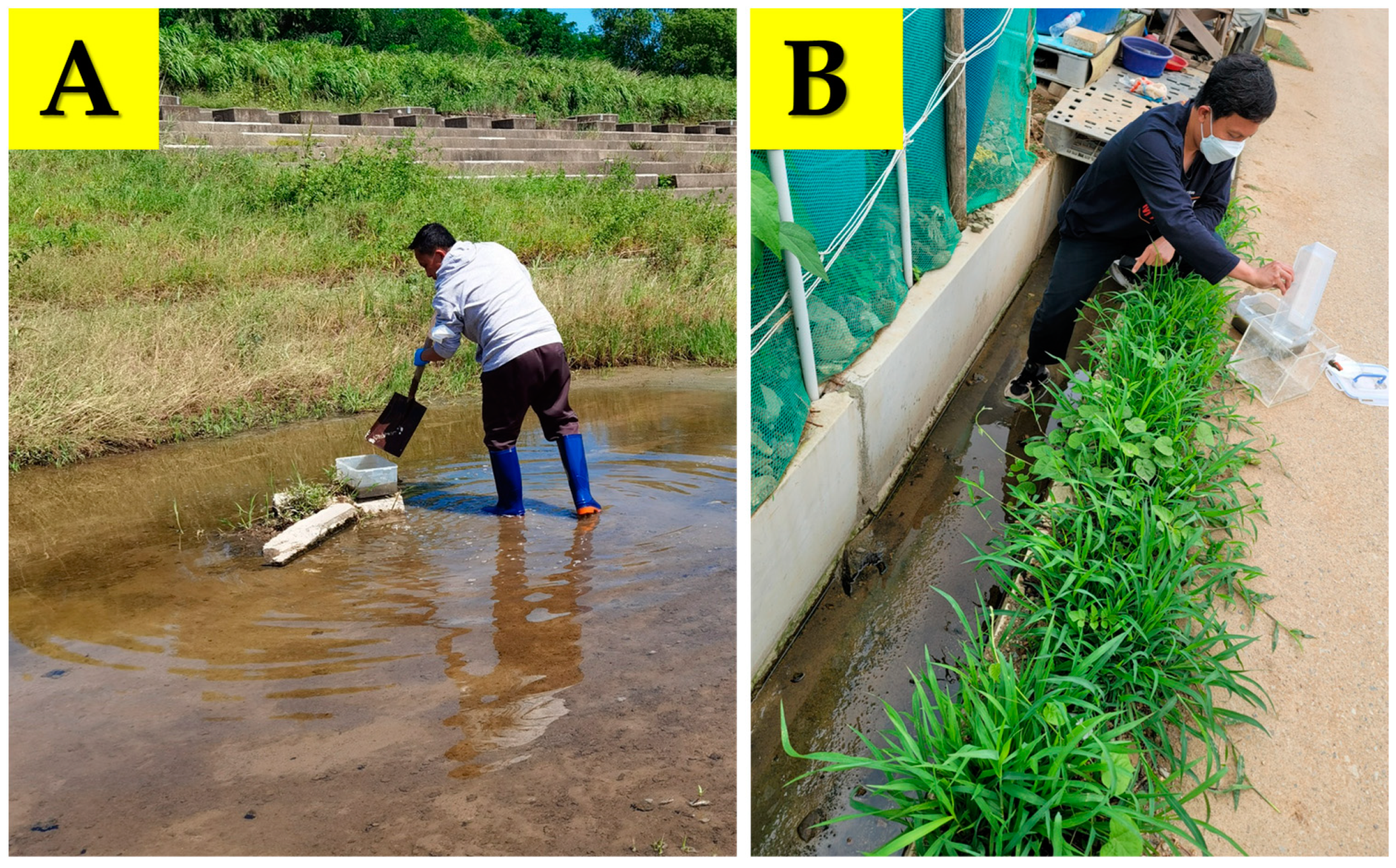

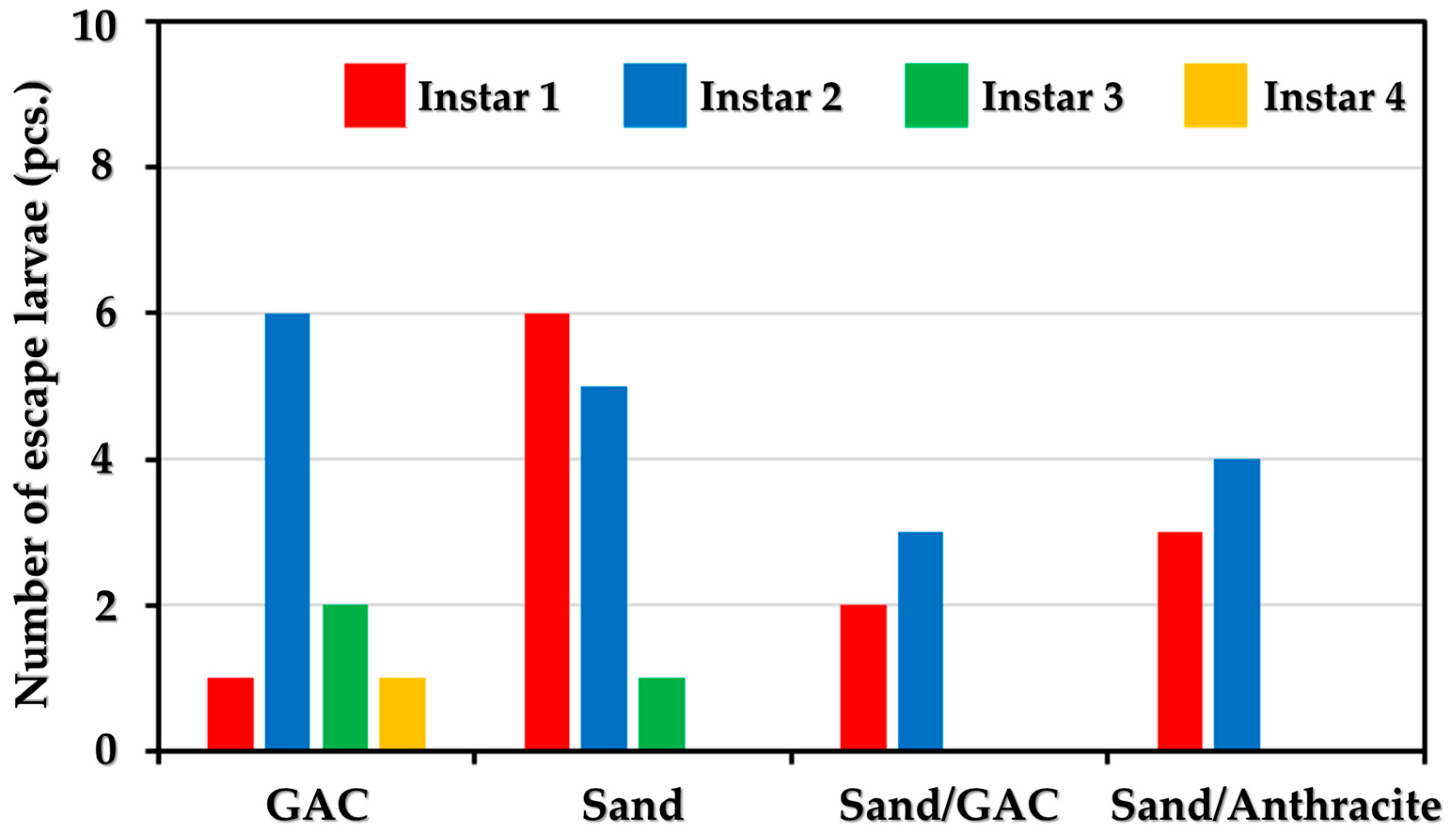
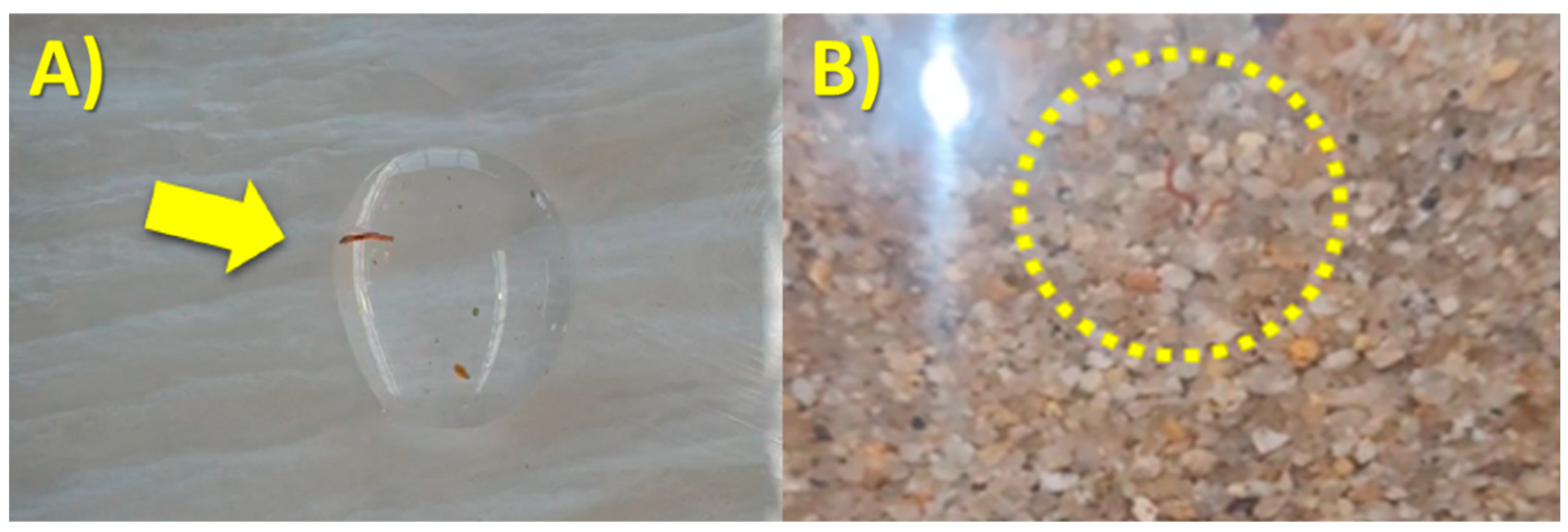
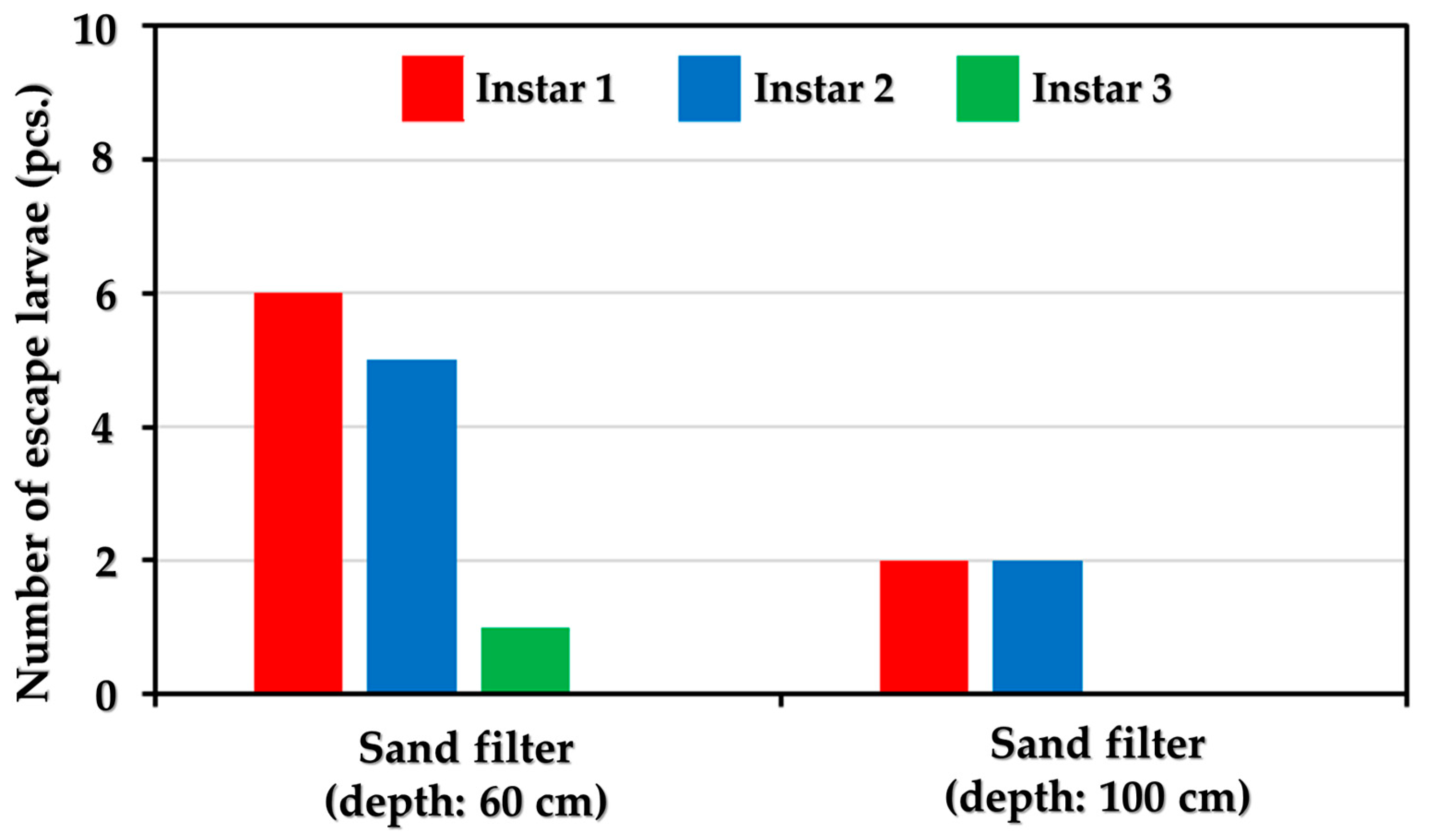
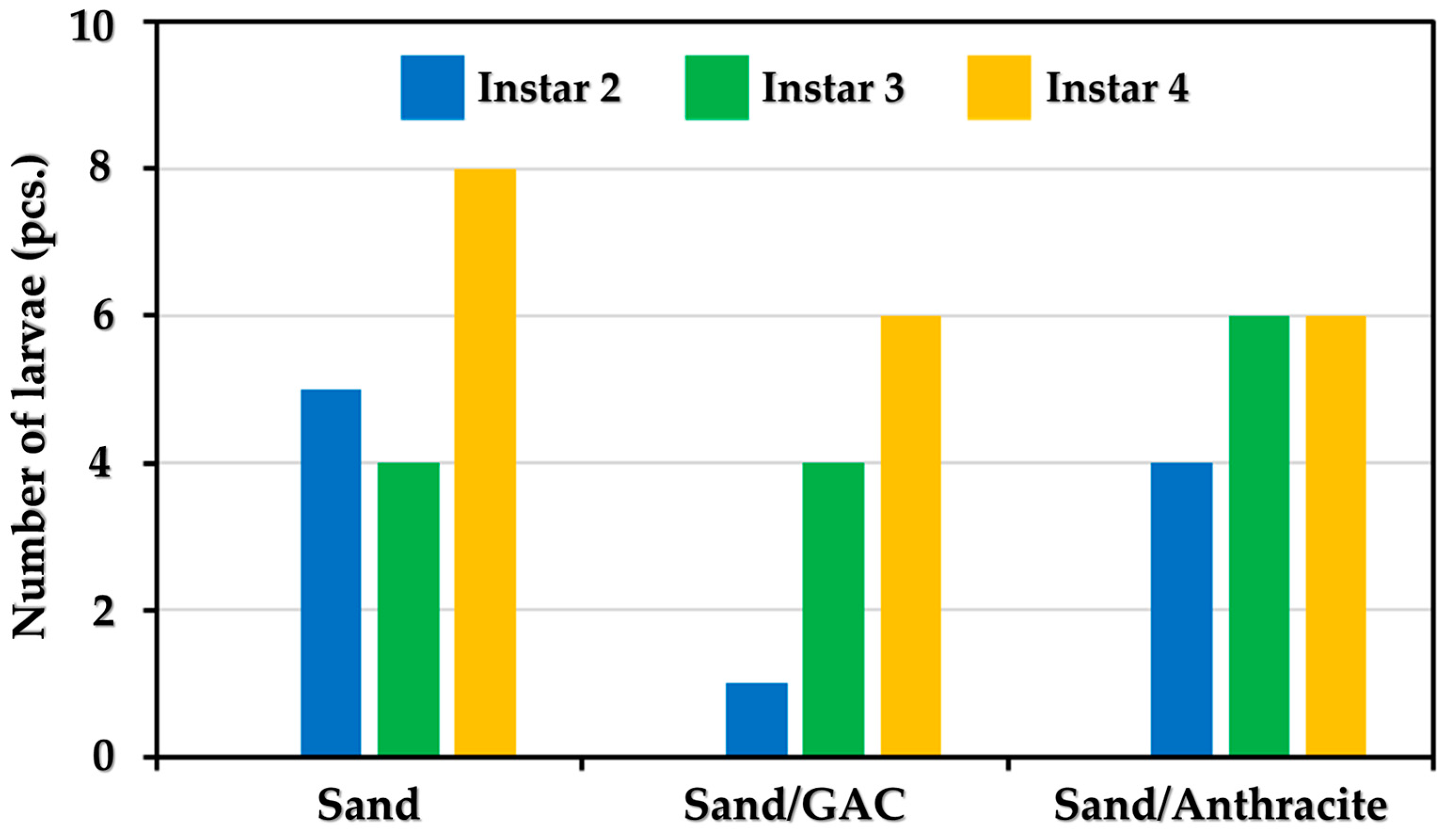
| Observation | Blank | Coag. 1 | Chlo. 2 | Coag. → Chlo. 3 | Chlo. → Coag. 4 |
|---|---|---|---|---|---|
| Number of escaped larvae (stage) | 1 (i-1) 5 | 2 (i-2) 6 | 1 (i-1) 1 (i-2) | 2 (i-2) | 3 (i-2) |
| Escape after (hour) | 11 h | 15 h | 12 h | 17 h | 19 h |
| Filtration (day) | 3 d | 3 d | 3 d | 3 d | 3 d |
| STATUS | FAILED | FAILED | FAILED | FAILED | FAILED |
| Observation | ES 1: 0.6 mm UC 2: 1.7 | ES: 0.6 mm UC: 1.5 | ES: 0.7 mm UC: 1.7 | ES: 0.7 mm UC: 1.5 |
|---|---|---|---|---|
| Number of escaped larvae (stage) | - | - | 2 (i-2) 3 | - |
| Escape after (hour) | - | - | 15 h | - |
| Filtration (day) | 3 d | 3 d | 3 d | 3 d |
| STATUS | SUCCEED | SUCCEED | FAILED | SUCCEED |
| Observation | Sand/GAC | Sand/Anthracite |
|---|---|---|
| Number of escaped larvae (stage) | - | - |
| Escape after (hour) | - | - |
| Filtration (day) | 3 d | 3 d |
| STATUS | SUCCEED | SUCCEED |
Disclaimer/Publisher’s Note: The statements, opinions and data contained in all publications are solely those of the individual author(s) and contributor(s) and not of MDPI and/or the editor(s). MDPI and/or the editor(s) disclaim responsibility for any injury to people or property resulting from any ideas, methods, instructions or products referred to in the content. |
© 2023 by the authors. Licensee MDPI, Basel, Switzerland. This article is an open access article distributed under the terms and conditions of the Creative Commons Attribution (CC BY) license (https://creativecommons.org/licenses/by/4.0/).
Share and Cite
Kwon, H.J.; Hidayaturrahman, H.; Koutavarapu, R.; Lee, T.G. Comprehensive Solutions to Prevent Larvae Breakout in Water Filtration Systems. Sustainability 2023, 15, 14881. https://doi.org/10.3390/su152014881
Kwon HJ, Hidayaturrahman H, Koutavarapu R, Lee TG. Comprehensive Solutions to Prevent Larvae Breakout in Water Filtration Systems. Sustainability. 2023; 15(20):14881. https://doi.org/10.3390/su152014881
Chicago/Turabian StyleKwon, Hyuk Jun, Haerul Hidayaturrahman, Ravindranadh Koutavarapu, and Tae Gwan Lee. 2023. "Comprehensive Solutions to Prevent Larvae Breakout in Water Filtration Systems" Sustainability 15, no. 20: 14881. https://doi.org/10.3390/su152014881
APA StyleKwon, H. J., Hidayaturrahman, H., Koutavarapu, R., & Lee, T. G. (2023). Comprehensive Solutions to Prevent Larvae Breakout in Water Filtration Systems. Sustainability, 15(20), 14881. https://doi.org/10.3390/su152014881







